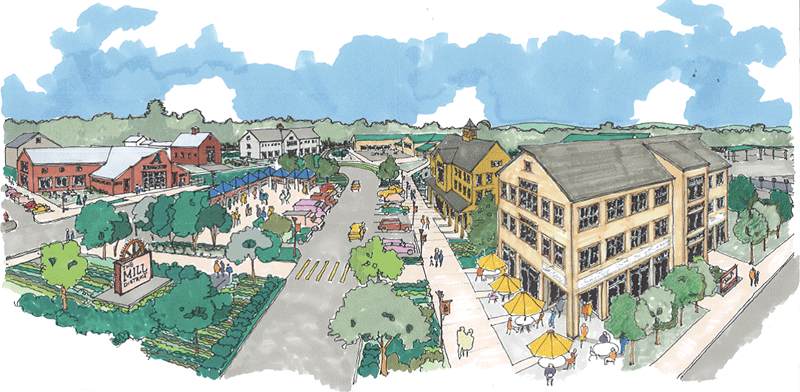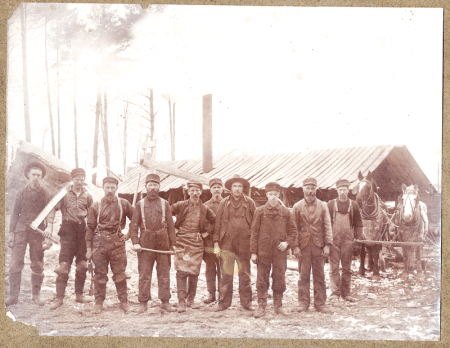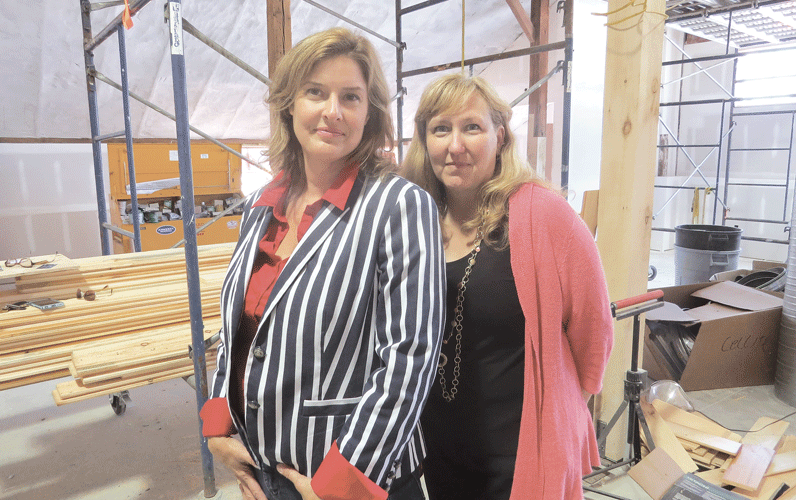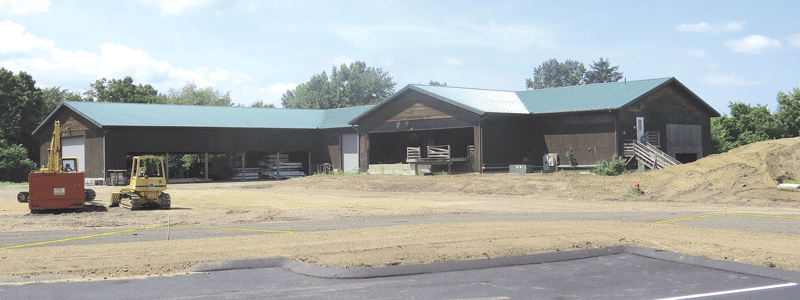
The Mill District Builds on the Cowls Family’s Legacy

Above, an architect’s rendering of the Mill District, the latest business venture for the Cowls/Jones family, which has operated everything from a farm to logging ventures, such as the one seen below, circa 1900.

Planting New Seeds at Cowls Mill District
It’s said to be a place “where history and opportunity meet.” That’s one of the marketing slogans being used for the Mill District in North Amherst. Over more than 250 years and nine generations of the Cowls/Jones family, the site has been home to everything from a trolley station to a cow barn; from one of the nation’s first electric saw mills to a massive building supply store. Now in its latest incarnation, it is being fashioned into a unique mixed-use facility, described, alternately, as a ‘destination’ and a ‘community.’
Cinda Jones says that each generation of her family, going back more than 250 years, has left its mark on the family business, which started as a dairy farm in what is now North Amherst — and also on the community.
Usually, several marks.
In 1741, for example, Jonathan Cowls, who would eventually serve the town as a selectman, acquired what was known as the Home Farm, which stretched across a long strip of land from what is now Route 63 west to the Hadley line. He would eventually expand the small farm into lumber manufacturing. And in 1768, Jonathan’s son, David Cowls, and Sarah (Eastman) Cowls built the farmhouse at 134 Montague Road. Nine generations of the same Cowls/Jones family have lived in that house, which has also served as the operations center for the family business.
Fast-forwarding more than 125 years, Walter Dickinson Cowls, or WD, as he was known, would expand that house. He would also help build the North Amherst Library and eventually give the family enterprise the name it still uses today — W.D. Cowls Inc. As a partner in Cowls & Childs, a contracting business, he built roads and undertook several large construction projects, such as the Amherst and Sunderland Street Railway System. He was also a selectman and later a state representative.
WD’s grandson, Walter Cowls Jones, meanwhile, would expand the business into real estate, and he’s credited with building one of the first, if not the first, electric saw mills in the country. He was Amherst’s water commissioner and chairman of the Planning Board. His son, Denison, founded DH Jones Real Estate in 1958 and built several apartment complexes. Denison’s brother, Paul, ran the family sawmill and timberland operations and built Cowls Building Supply on the Home Farm site in 1980.
“There’s a long legacy of business innovation and community involvement,” said Cinda Jones, Paul’s daughter and current president of W.D. Cowls Inc., and one that she and her bother, Evan, many cousins, and even a niece (the 10th generation involved with the family business) are continuing.

Cinda Jones, left, and Mollye Wolahan stand in Sarah Cowls’ cow barn, currently being transformed into an Atkins Farms Country Market.
An intriguing work in progress, it embodies the past, present, and future, and is an ambitious redevelopment effort that involves several of the buildings and business operations started or expanded by previous generations of the Cowls/Jones family.
For example, on the site of what used to be a trolley barn on the north side of Cowls Road sits a new development called, appropriately enough, the Trolley Barn. It now houses The Lift salon, the Bread & Butter restaurant, and several apartments on the upper floors. Across the street and a few hundred yards to the east, in what’s still known as Sarah Cowls Cow Barn (named after WD’s only child), an Atkins Farms Country Market is taking shape, with an August soft opening planned.
There are other buildings and sites still to be developed, including a 14,400-square-foot saw mill, a replacement for the one Walter Cowls Jones built and that burned to the ground in 2001; the so-called Onion Barn; several mill houses along Cowls Road, and former farmland stretching to Route 116 called Goat Meadow. Potential uses range from additional retail to facilities for the arts to senior housing.
But Jones told BusinessWest that this development is not simply about finding new uses for properties named by and for her ancestors. It’s also about creating what she described, alternately, as a community and a destination, something she believes is sorely needed in an area less than a mile north of the UMass Amherst campus and three miles from Amherst Center.
“The vision for the Mill District is for an eats, arts, and entertainment destination, built with respect for our industrial and agricultural past and reflecting that history,” she explained. “This is where history and opportunity meet; it would be a place where you would have unique experiences not found on the Internet, a destination for not just college students, but people of all ages.”
For this issue and its focus on commercial real estate, BusinessWest talked with Jones and Mollye Wolahan, vice president of Real Estate and Commercial Development for W.D. Cowls Inc. about the Mill District and how it has the potential to change the landscape in North Amherst in myriad ways.
Board Feat
As she talked with BusinessWest in that farmhouse on Montague Road built by David and Sarah Cowls, Cinda Jones was supremely confident that the new Atkins Farms market, and the Mill District as a whole, would thrive.
And when asked why, she quickly dove into a discourse on geography — and business — concerning that decidedly rural area north and west of Amherst, starting with the town of Gill, population 1,500, where she lives.

The new Atkins taking shape in the Mill District, set for a soft opening next month, is expected to be an anchor for the North Amherst development.
“Most people who work at UMass, in Amherst, and in points beyond, commute from more-affordable towns,” she went on. “These commuters are demanding better shopping and stopping options on their way home.”
This food desert, coupled with the need to redevelop several of the family’s shuttered or underperforming facilities, such as the saw mill, eventually led to the years-long process of conceptualizing the Mill District and then making it reality.
“We always knew that we would have the chance to do what every generation before us did, which was to figure out what our generation needed and then build it on the Home Farm site,” Jones explained. “The saw mill was sucking wind — it was losing money on 20 acres of land a half-mile north of UMass Amherst, and we decided to build what we know this area needs.”
And also build what is permitted on the commercially zoned property, she added quickly, noting that attempts to amend the zoning to allow more residential density have thus far failed. If that situation should change, then the future course of the district may be reshaped. But for now, the company is dealing with the present reality — meaning both the zoning laws and needs within the community.
This goal for the property is captured in an architect’s rendering of the district that is used as a marketing piece. It shows a mixed-use facility teeming with activity of both sides of Cowls Road. The image represents that mix of commercial and residential development that is sought, as well as a sense of community that both Jones and Wolahan described.
“We want to create a sense of place here in North Amherst,” said Wolahan, who brings a diverse resume to her assignmemt, including work as community development director for the Town of Mountain Village, the resort town adjacent to Telluride in Colorado. “And we found with the opening of the Trolley Barn and also with people coming into our office to explore opportunities with us is that there is such a demand for services and activities in this area.
“There is a large community here that doesn’t have the same services available in downtown,” she went on, adding that there is considerable vehicular traffic in the area on Routes 116 and 63. “There are a lot of families and many students living here, and what we’re trying to do is build on what’s already here and create not just the bricks and mortar, but the sense of community as well.”
While talks with Atkins about creating a presence in North Amherst and, more specifically, on the Cowls/Jones property had been going on for years (more on them later) the first piece of the Mill District development was the Trolley Barn.

The Trolley Barn, now home to The Loft salon, Bread & Butter restaurant, and several apartments, opened its doors last year.
“Bread & Butter was packed when it first opened,” she recalled. “And it has pretty much stayed that way ever since.”
What’s in Store
When asked how she eventually corralled Atkins as a tenant, Jones didn’t mince words, and only needed a few of them.
“We begged them, begged, them, begged them, and begged them some more,” she said, adding that to cinch a deal, the developers essentially took as much of the risk out of the equation as possible, building out the property to suit and pledging to expand it if (or, more likely, when, Jones predicted) need arises.
That property, a.k.a. the Cow Palace, was, as the name suggests, a functioning dairy barn until only a few decades ago and more recently served as a lumber-storage area. The property bears Sarah Cowls’ name, because it was her operation, said Jones, adding that she was a cattle farmer who also bred sheep, pigs, chickens, dogs, and peacocks, while also growing onions, corn, tobacco, and potatoes.
The barn was actually the third property on the site presented to Atkins as a potential new home, said Jones, adding that she first proposed the saw mill and later the Trolley Barn site, before the company became sold on the dairy barn.
As she offered BusinessWest a tour of the Atkins facility, Jones said the store represents mostly historic preservation, with most all of the old barn kept intact.
The new Atkins will not have a kitchen, so foods will not be prepared there, she said, adding quickly that prepared items will be transported to the new site from the South Amherst flagship facility several times a day. And overall, the new location will offer essentially everything the company sells — from apples and cider donuts to floral arrangements; from cheese to meats.
Atkins is expected to serve as the Mill District’s anchor, said Wolahan, adding that it will likely bring the volume of traffic that can attract other kinds of businesses and create the momentum needed to make that conceptual rendering of the area in question a reality.
Once Atkins is up and running and traffic within the facility increases, both Jones and Wolahan expect other pieces of the Mill District picture to fall into place.
Indeed, while walking past the old saw mill, closed in 2010, Jones said its future use is limited only by one’s imagination.
“We could tear that structure down and build a 3 ½-story building on top, and that would probably be the smartest thing to do,” Jones explained. “But with so many acres of open space, I’m hoping to lease that space.”
As an example of what might work there, she cited Kings Bowl, which has several locations in the Northeast and as far south as Orlando. Billing itself as “the classy bowling joint,” it features a host of games in addition to bowling — shuffleboard, skee ball, and air hockey, for example — as well as a restaurant and bar. Such a concept, said Jones, would certainly be appealing in the five-college area.
Meanwhile, another small barn on the property, known as the antique barn, is drawing some interest from a bank as the possible site of a branch and community center, said Jones, adding that those talks are preliminary in nature, as are discussions with UMass Amherst about utilizing one of the facilities as a possible home for startups.

Cinda Jones says the saw mill on the family’s property, a replacement for the one Walter Cowls Jones built, presents a number of development opportunities.
Overall, discussions are being conducted with potential tenants in many categories, said Wolahan, adding that a number of multi-family housing developers have expressed interest because the zoning permits commercial businesses on the ground floors of properties and residential above, as seen in the Trolley Barn.
One of Wolahan’s current assignments is to finalize a master plan for the site, which will essentially act as a road map for developing the various properties and parcels.
Plane Speaking
As she talked about the need for a destination, one that would create experiences for people of all ages, Jones referenced her nieces and nephews, some of whom who are already working at W.D. Cowls, and thus represent the 10th generation of the family to do so.
“There’s no place for them to go around here, no place to go and have fun,” she noted, adding that creating such a place constitutes one of the many ways she intends for her generation to leave its mark on the Cowls business — and the community.
Indeed, the family that has been writing history for three centuries is poised to script some exciting new chapters.
George O’Brien can be reached at [email protected]





